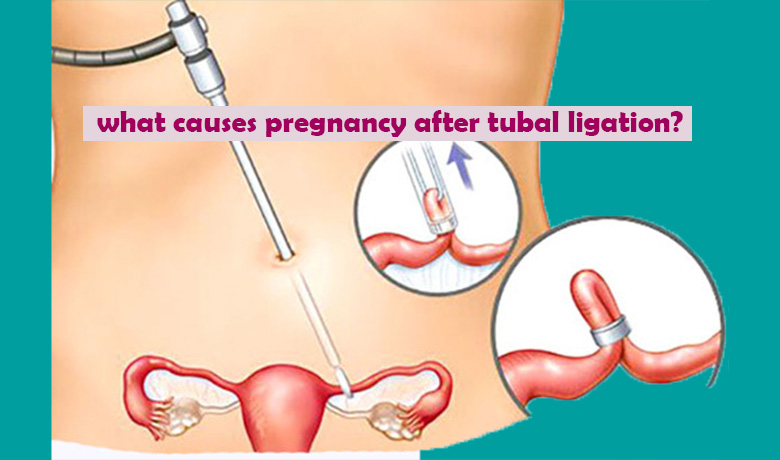what causes pregnancy after tubal ligation?

Tubal ligation, commonly known as “getting your tubes tied,” is a method of permanent birth control for women. This surgical procedure involves blocking or cutting the fallopian tubes, which prevents the fertilized egg from reaching the uterus, making pregnancy unlikely. However, there is still a small chance of pregnancy after tubal ligation, with approximately 1 in 200 women experiencing it.
Tubal ligation, also known as “getting your tubes tied,” is a choice for women who no longer wish to have children. This outpatient surgical procedure involves blocking or cutting the fallopian tubes. This prevents an egg released from the ovary from reaching the uterus, where fertilization typically occurs.
While tubal ligation is highly effective in preventing most pregnancies, it’s not foolproof. An estimated 1 out of every 200 women may experience pregnancy after tubal ligation.
Tubal ligation can also raise the risk of ectopic pregnancy, where a fertilized egg implants itself in the fallopian tubes rather than reaching the uterus. This can lead to a medical emergency, so recognizing the symptoms is crucial.
Related posts: Overactive thyroid in pregnancy
What’s the pregnancy risk after tubal ligation?
During a tubal ligation, a surgeon may band, cut, seal, or tie the fallopian tubes. Pregnancy can happen if these tubes reconnect after the procedure.
The likelihood of this happening is higher for younger women undergoing tubal ligation. According to the University of Pittsburgh Medical Center, the pregnancy rates after tubal ligation are:
- 5 percent for women under 28
- 2 percent for women aged 28 to 33
- 1 percent for women over 34
Signs of Pregnancy
In the event that your fallopian tube reconnects after tubal ligation, the potential for a full-term pregnancy exists. Some women may consider undergoing a tubal ligation reversal procedure, in which a medical professional rejoins the fallopian tubes. While not always a guaranteed method for women desiring pregnancy, it can prove effective.
Indications of pregnancy encompass:
- Breast tenderness
- Cravings for certain foods
- Nausea triggered by thoughts of specific foods
- Menstrual cycle interruption
- Morning sickness, especially during the early hours
- Unexplained fatigue
- Increased frequency of urination
If you suspect pregnancy, an at-home pregnancy test is an option. However, bear in mind that these tests might not provide 100 percent accuracy, particularly in the early stages of pregnancy. To confirm pregnancy, your healthcare provider can conduct a blood test or ultrasound.
Ectopic Pregnancy Risks
An ectopic pregnancy, often known as a tubal pregnancy, arises when a fertilized egg attaches itself outside the uterine lining. While fallopian tubes are the most common location for this to occur, implantation can also take place in the cervix, ovary, or abdominal cavity.
Embryos can solely develop within the uterus. Ectopic pregnancies do not progress normally and never lead to a viable baby. If left untreated, ectopic pregnancies can pose a life-threatening situation due to potential ruptures and internal bleeding.
The possibility of a tubal pregnancy increases with tubal ligation. Roughly one-third of pregnancies post-tubal ligation are ectopic and non-viable.
Tubal ligation reversal also elevates the risk of ectopic pregnancy by approximately 2–7%.
In case of an ectopic pregnancy, typical early pregnancy symptoms might occur, along with specific warning signs, such as abdominal or pelvic pain, varying degrees of vaginal bleeding, low back pain, and even shoulder pain.
Immediate medical attention is essential upon suspicion of a tubal pregnancy.
Fallopian Tube Reconnection Mechanism
Reuniting fallopian tubes is not a seamless process. Instead, they reconnect via a fistula formation, often resulting from surgery, injury, or inflammation like that from pelvic inflammatory disease. This new connection allows sperm to potentially reach an egg, though it’s typically too narrow for an egg to traverse. Consequently, fertilization might occur higher up in the tube than usual.
Since the newly formed passage might be too constricted, the fertilized egg could remain lodged in the tube, resulting in an ectopic pregnancy.
Tubal Ligation’s Birth Control Effectiveness
Tubal ligation is a considered safe, effective, and permanent method of birth control. Despite its intended permanence, it’s not infallible. The failure rate during the first year after the procedure is estimated at 0.1–0.8%.
Reversing Tubal Ligation Decision
Life’s unpredictability sometimes leads to regrets about tubal ligation. A 2016 US study indicated that 28% of individuals who underwent tubal ligation regretted their decision, especially those under 30 years old.
Reasons for reversal might include changing desires for more children, altered partnerships, or improved financial conditions. If such considerations arise, consult a healthcare professional for guidance.
Feasibility of tubal ligation reversal varies based on factors like the initial procedure, remaining undamaged tube length, age, and surgeon’s experience. Success rates for a healthy pregnancy after successful reversal range from 50–80%.
Alternative Fertility Options
In vitro fertilization (IVF) has proven successful for individuals who’ve undergone tubal ligation. IVF bypasses blocked fallopian tubes by fertilizing eggs externally and transferring embryos directly to the uterus.
IVF success depends on factors like age, egg quality, and overall health. Donor eggs or sperm might provide viable options in certain situations.
Why did I get pregnant after tubal ligation?
Is it common to get pregnant after tubal ligation?
What is the most common cause of a tubal pregnancy?
Why do you still ovulate after tubal ligation?
Can you still produce eggs after tubal ligation?
Conclusion:
While tubal ligation is highly effective in preventing pregnancies, it’s not foolproof. In some cases, the fallopian tubes can grow back together, leading to the potential of a tubal or ectopic pregnancy. This occurrence poses risks and can be life-threatening if not addressed promptly. It’s essential for individuals who suspect pregnancy after tubal ligation to be vigilant about symptoms and seek medical attention when needed. Moreover, factors such as age, type of procedure, and personal circumstances should be carefully considered when contemplating tubal ligation or its reversal.
